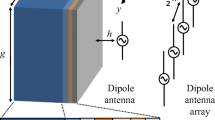Abstract
The electromagnetic compatibility (EMC) of 400 MHz radio communications is an issue of growing interest, especially the EMC of wireless medical telemetry (WMT) in clinical settings. Electromagnetic interference (EMI) by radiation noise emitted from switched-mode power supplies built into light-emitting diode (LED) lights is now of considerable interest for the safe operation of WMT. Moreover, the 400 MHz frequency bands that are allocated for WMT are also shared and used for other radio communication systems. In this work, we studied the EMI problem of WMT used in Japan. We experimentally investigated EMI with WMT caused by electromagnetic noise emitted from LED lights. In addition, we suggested countermeasures for these EMI issues and the management of an electromagnetic environment by a very simplified method.










Similar content being viewed by others
References
Yao, W., Chu, C.H., Li, Z., The adoption and implementation of RFID technologies in healthcare: a literature review. J. Med. Syst. 36(6): 3507–3525, 2012. https://doi.org/10.1007/s10916-011-9789-8
Javanov, E., Milenkovic, A., Body area networks for ubiquitous healthcare applications: Opportunities and challenges. J. Med. Syst. 35(5): 1245-1254, 2011. https://doi.org/10.1007/s10916-011-9661-x
Baig, M.M., Afifi, S., GholamHosseini, H., Mirza, F., A Systematic Review of Wearable Sensors and IoT-Based Monitoring Applications for Older Adults – a Focus on Ageing Population and Independent Living. J. Med. Syst. 43(8): 233, 2019. https://doi.org/10.1007/s10916-019-1365-7
Electromagnetic Compatibility Conference Japan (2016) “Guidance for using an electric wave safe and safely in a hospital,” Association of Radio Industry and Business.
Hanada E., Ishida K., Kudou T., Newly identified electromagnetic problems with medical telemeter systems. Prz. Elektrotech. 94(2): 21-24, 2018. https://doi.org/10.15199/48.2018.02.06
Ishida K., Arie S., Gotoh K., Hanada E., Hirose M., Matsumoto Y., Electromagnetic compatibility of wireless medical telemetry systems and light-emitting diode (LED) lamps. Prz. Elektrotech. 94(2): 25-28, 2018. https://doi.org/10.15199/48.2018.02.07
Association of Radio Industries and Businesses (2015) STD-21 ed.3.0, Medical telemeter radio equipment for specified low-power radio station.
Federal Communications Commission (1999) Wireless Medical Telemetry Service (WMTS).
Fujii K., Ohno Y., Kido M., Ishida K., Jeong H., Effect of wandering sensing systems on wireless medical telemetry systems. Jpn. J. Med. Inf. 38(6): 321-336, 2018.
Kanno S., Hirasawa N., Akiyama Y., A study on the correlation between common mode voltage measured by using CDNE and radiated electromagnetic field strength emitted from LED bulbs. IEICE Tech. Rep. EMCJ 2011-12: 13-17, 2011.
International Special Committee on Radio Interference (2018) CISPR 15 ed. 9.0, Limits and methods of measurement of radio disturbance characteristics of electrical lighting and similar equipment.
Wu I., Ohta H., Gotoh K., Ishigami S., Matsumoto Y., Characteristics of radiation noise from an LED lamp and its effect on the BER performance of an OFDM system for DTTB. IEEE Trans. Electromagn. Compat. 56(1): 132-142, 2014. https://doi.org/10.1109/TEMC.2013.2277596
Ishida K., Wu I., Gotoh K., Matsumoto Y., Evaluation of Electromagnetic Noise Emitted from Light-Emitting Diode (LED) Lamps and Compatibility with Wireless Medical Telemetry Service. IEICE Trans. Commun. E103-B(6): 637-644, 2020. https://doi.org/10.1587/transcom.2019HMP0003
Ishida K., Arie S., Wu I., Gotoh K., Matsumoto Y., Impact of LED Lamp Noise on Receiver Sensitivity of Wireless Medical Telemetry System. IEICE ComEX. 7(11): 421-426, 2018. https://doi.org/10.1587/comex.2018XBL0096
Wiklundh K., Relation between the amplitude probability distribution of an interfering signal and its impact on digital radio services. IEEE Trans. Electromagn. Compat. 48(3): 537-544, 2006. https://doi.org/10.1109/TEMC.2006.877782
Otsuka T., Pitfalls of using medical machines on the wards: In case of wireless biomedical monitoring system. JJMI 75(11): 822-827, 2005.
Stenumgaard P., A simple impulsiveness correction factor for control of electromagnetic interference in dynamic wireless applications. IEEE Commun. Lett. 10(3): 147-149, 2006. https://doi.org/10.1109/LCOMM.2006.1603366
Matsumoto Y., Relation between impulsiveness correction factor and amplitude probability distribution of impulsive interference for estimating its impact on communication systems. IEICE ComEx, 1(1): 10-15, 2012. https://doi.org/10.1587/comex.1.10
Fors K., Wiklundh K., Stenumgaard P., A simple measurement method to derive the impulsiveness correction factor for communication performance estimation. IEEE Trans. Electromagn. Compat., 55(5), 834-841, 2013. https://doi.org/10.1109/TEMC.2012.2236090
Wu I., Ishigami S., Matsumoto Y., Evaluation of distribution of switching noise generated by LED lamp on lighting duct rail. IEICE ComEX. 2(11): 478-483, 2013. https://doi.org/10.1587/comex.2.478
Ishida K., Fujioka T., Endo T., Hosokawa R., Fujisaki T., Yoshino R., Hirose M., Evaluation of electromagnetic fields in a hospital for safe use of electronic medical equipment. J. Med. Syst. 40(2): 46, 2016. https://doi.org/10.1007/s10916-015-0411-3
Muraki Y., Overview of the Wireless Medical Telemetry System and its Reception Interference (in Japanese). Jpn. J. Med. Inf. 36(Suppl.): 114-116, 2016.
Author information
Authors and Affiliations
Corresponding author
Ethics declarations
Conflict of interests
The authors declare that they have no conflict of interests.
Ethical approval
This article does not contain any studies with human participants or animals performed by any of the authors.
Additional information
Publisher’s Note
Springer Nature remains neutral with regard to jurisdictional claims in published maps and institutional affiliations.
This article is part of the Topical Collection on Systems Level Quality Improvement
Rights and permissions
About this article
Cite this article
Ishida, K., Wu, I., Gototh, K. et al. Electromagnetic Compatibility of 400 MHz Radio Communications in Hospitals: Safety Management of Wireless Medical Telemetry. J Med Syst 44, 154 (2020). https://doi.org/10.1007/s10916-020-01629-z
Received:
Accepted:
Published:
DOI: https://doi.org/10.1007/s10916-020-01629-z




